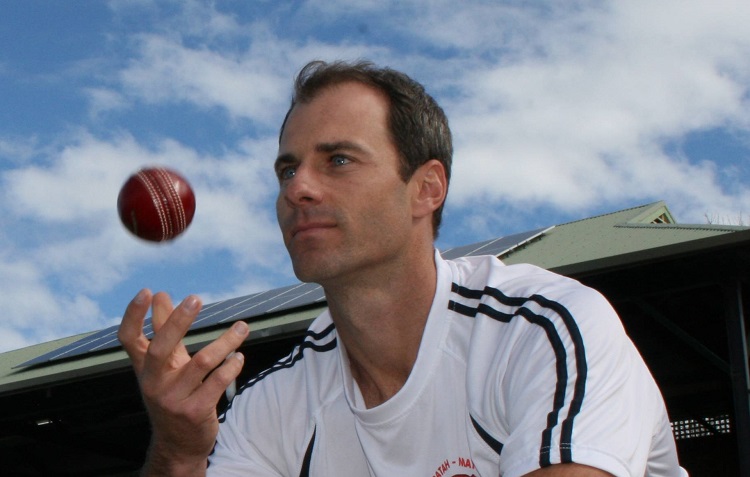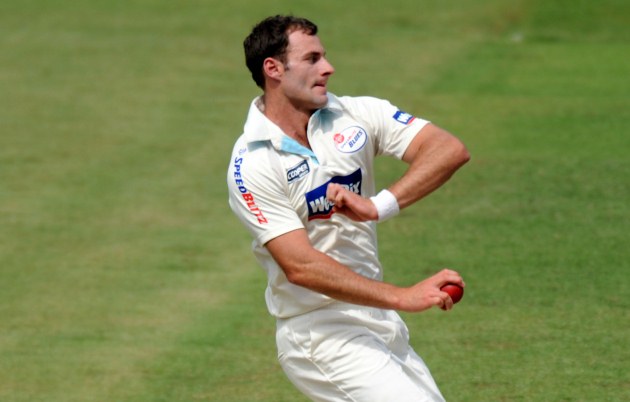
High Performance Fitness from Down Under
One of the main things that Americans just discovering cricket have to wrap their brains around is the difference between pitching a baseball and bowling a cricket ball. And it's a lot more than just keeping your arm straight. As a result, the risks and injuries that go along with bowling a cricket ball are a whole lot different than those that go along with pitching a baseball. Shoulder issues? Tommy John surgery? Not so much in cricket. Instead, try lower back stress fractures and foot injuries. I spoke with USA Cricket strength and conditioning coach, Burt Cockley, about cricket-specific fitness and what it takes to keep bowlers safe and healthy. And he should know. Not only is he one of the fastest bowlers to ever come out of Australia, but he's also had just about every injury a bowler can sustain.
"I've experienced stress fractures, bulging discs, multiple side strains, a broken rib from bowling, multiple ankle surgeries, and I'm apparently the only reported case in cricket of an ACL rupture from front foot contact."
Growing up in Newcastle -- a blue collar mining town in New South Wales -- Cockley did what most kids did. He played rugby and cricket and looked for ways to make himself better at both. "When I was a kid, I never had any access to any formal strength and conditioning programming. I'd ride myself to the gym when I was 15 and my dad had old body building magazines. So I would look at these body building magazines, replicate the workouts, and then drive my bike out to the nets and bowl. That was my primitive early doors of sport science, not knowing what I was doing, but trying to make it up."
And while a solid workout routine is a great thing, it didn't quite prepare him for the specific rigors of being a fast bowler. Injuries forced him to go through changes to his bowling action, but the injuries continued. "Once I got playing professionally, that's when the doors opened up on sports science -- awesome physios, sports medicine, proper gyms, proper training, periodization. I was loving it. I didn't know my love for training and exercise could have been a career option because (laughing) I didn't care at school and I didn't pay any attention. It wasn't until I got contracted and there was a strength and conditioning coach and a sports doctor and a physio that I realized that I could actually have this as a career."

"Being a professional athlete is a very volatile career. It's all roses one day and the next day you're down and out. Even though I was bowling quicker than everyone else in Australia at the time, my body was breaking down. So I started putting things in place. I would do a personal training certificate and then my Level One Australian strength and conditioning certificate. And it kept building. Whenever I was injured, I'd have eight months out so I would spend that time studying and making the most of my time. It wasn't until I had a few more injuries that I realized maybe my career isn't going to be that long."
At 27, he enrolled at Edith Cowan University in Perth and received a degree in Sports Science. After graduating, he left Australia and moved with his wife to Kansas where they'd be closer to her family. In the States, he furthered his education by earning his master's degree at the University of Kansas and, while there, was able to intern with both the university's football and basketball programs. "Coming to the US and getting involved with collegiate sport was really cool. My whole goal after I finished playing cricket was to get back into professional sport and high performance and be a coach. I wanted to use all my skills, the experiences that I've gone through, and my education to help other cricketers not go through what I went through."
Through connections made from a career of playing, Cockley caught on with USA Cricket, where was given the daunting task of overseeing the training of the men's team, the women's team, both men's and women's Under-19 squads, and Major League Cricket players. "I was the first strength and conditioning coach for USA Cricket. And there was no preexisting anything. There were no benchmarks, expectations, or standards. So, I came in and was like, okay, we're doing testing. And this is what it is. And this is where I want you to be. What most coaches don't understand is what the game demands physiologically. How far is a player going to run in any given T20 game or one-day game or Test match? How many high-speed running meters are they going to be completing? How many times are they going to bowl a cricket ball? How many times are they going to throw a cricket ball? What's the game going to demand from the athlete and how am I going to prepare that athlete to meet those demands?"

"If a player hasn't done enough bowling and enough running volume going into an ODI series where they're going to be playing four games in six days, they're going to be hurting. They’re going to be tight -- tight ankles, hips are going to be tight. They're going to lose spinal rotation. And when the joints aren't moving the way they should be, they get stressed a lot more and that's when injuries are going to arise. I'm big on the work that needs to be done beforehand to make sure that players have the work capacities and muscular endurance, so that their threshold is so high that playing a game of cricket is just below that threshold and it's not too much of a shock for their system."
"Bowling is the crazy animal. You've got ground reaction forces, rotating, flexing, the ribs and hips are smashed in together, and you're doing that time and time again -- running in at 25 kilometers-an-hour and coming to a complete halt. That's a most unnatural thing. There's not many things in sport other than javelin-throwing that's physiologically so demanding. And with javelin, maybe it's less than ten throws in competition. Bowlers will warm up and then they'll bowl 60 balls at match intensity in a 50-over game. I know what it's like when I have two overs to bowl the death. If I'm not fit, I'm not thinking clearly, I'm not executing, and I'm going to get hit for more runs."
And the difference between working with bowlers and working with batters? "In a 50-over game, a batter might go out, open the innings, and get a hundred. And he's out there for three hours. The next day, he might get out second ball. So game one, he's batted for three hours in 40 degrees (Celsius) and he's done three kilometers of high-speed running up and down the wicket. Physiologically, that's a lot of stress. Whereas, if he goes out second ball, that's quite different. If they're spending a lot of time in the middle and running up and down, their match fitness is just going to increase. If they're not spending a lot of time in the middle, they're not getting that same amount of volume, so you got to make it up elsewhere. If you don't get any runs and you're standing at slip all day or short cover, you got to make up some work because you're not really doing a whole lot."
Cockley is optimistic about his second career in cricket. "I was adamant on becoming educated and re-shaping myself by doing a sports science degree and doing a master's degree and going into other sports and doing internships to up-skill my knowledge, so I could come back to cricket and see it with new eyes."
But that doesn't mean he's completely given up on his original career in cricket. He took four wickets in a handful of games with Minor League Cricket's Dallas Mustangs this past season. And he can still bring the heat. Just ask USA Cricket's Ryan Scott, who's probably still sporting a bruise from being drilled in the forearm by a Cockley delivery during a match this summer.
Ultimately, though, his future is about keeping athletes healthy. And that brings him back to his roots. "I've been shaped and molded by my own personal experiences from Australia. We're a little country; we've only got twenty-four million or twenty-five million people. We don't have this huge population of athletes, so we've got to do a really good job of athlete development. It's not like one athlete drops down and there's 15 others who are just as good. You don't have that ability in Australia, so you really got to work hard at keeping people fit. That's how I've been shaped."
© CricAmerica.com/Steve Steinberg 2022





One Comment
Working at Walmart
Nice post.